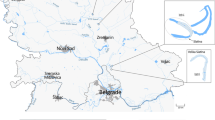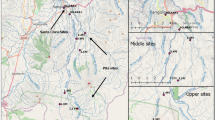Abstract
Classification of taxa into ecological guilds is based on the relation of respective taxa to nutrient enrichment and their resistance to physical disturbance. We hypothesized that ecological guild’s proportion and their taxa composition were strongly effected both by extremely changing water regime and nutrient contents. Diatom composition, guild dynamics and the diatom-based ecological status assessment index were studied in the Sebes-Körös River (South-East Hungary) in a year with extremely changing water regimes. There were highly pronounced changes in species composition during the whole vegetation period including the formation of running and standing water segments in autumn. While the proportions of ecological guilds showed no significant correlations with the studied environmental parameters, they were more balanced in high water discharge period than in the low water discharge period. Taxa compositions of segments were mainly determined by the preferences and strategies of a respective species and/or genera, regardless to their guild affiliation. These results point out that ecological guild characterisation should be refined using ecological knowledge at the subgenus level. We suggest to establish several subdivisions within the guilds to consider the differences in life strategies (CSR model) and life forms, and to implement the accumulated knowledge of nutrient preferences/indication of a respective taxa.







Similar content being viewed by others
References
Ács, É., K. Szabó, Á. K. Kiss, B. Tóth, G. Záray & K. T. Kiss, 2006. Investigation of epilithic algae on the River Danube from Germany to Hungary and the effect of a very dry year on the algae of the River Danube. Archive für Hydrobiologie 158: 389–417.
Berthon, V., A. Bouchez & F. Rimet, 2011. Using diatom life-forms and ecological guilds to assess organic pollution and trophic level in rivers: a case study of rivers in south eastern France. Hydrobiologia 673: 259–271.
Biggs, B. J. F., D. G. Goring & V. I. Nikora, 1998. Subsidy and stress responses of stream periphyton to gradients in water velocity as a function of community growth form. Journal of Phycology 34: 598–607.
Bolla, B., G. Borics, K. T. Kiss, M. N. Reskóné, G. Várbíró & É. Ács, 2010. Recommendations for ecological status assessment of lake Balaton (largest shallow lake of central Europe), based on benthic diatom communities. Vie Milieu 60: 1–12.
Chetelat, J., L. Cloutier & M. Amyot, 2010. Carbon sources for lake food webs in the Canadian High Arctic and other regions of Arctic North America. Polar Biology 33: 1111–1123.
De Fabricius, A. L. M., N. Maidana, N. Gómez & S. Sabater, 2003. Distribution patterns of benthic diatoms in a Pampean river exposed to seasonal floods: the Cuarto River (Argentina). Biodiversity and Conservation 12: 2443–2454.
Fairchild, G. W., R. L. Lowe & W. B. Richardson, 1985. Algal periphyton growth on nutrient-diffusing substrates: an in situ bioassay. Ecology 66: 465–472.
General Directorate of Water Management, homepage. http://www.vizugy.hu.
Gottschalk, S. & M. Kahlert, 2012. Shifts in taxonomical and guild composition of littoral diatom assemblages along environmental gradients. Hydrobiologia 694: 41–56.
Hungarian Meteorological Service, homepage. http://www.met.hu.
Johnson, R. E., N. C. Tuchman & C. G. Peterson, 1997. Changes in the vertical microdistribution of diatoms within a developing periphyton mat. Journal of the North American Benthological Society 16: 503–519.
Kireta, A. R., E. D. Reavie, G. V. Sgro, T. R. Angradi, D. W. Bolgrien, B. H. Hill & T. M. Jicha, 2012. Planktonic and periphytic diatoms as indicators of stress on great rivers of the United States: testing water quality and disturbance models. Ecological Indicators 13: 222–231.
Koshmanesh, A., F. Lawson & I. G. Prince, 1997. Cell surface area as a major parameter in the uptake of cadmium by unicellular green microalgae. Chemical Engineering Journal 65: 13–19.
Kovács, Cs, M. Kahlert & J. Padisák, 2006. Benthic diatom communities along pH and TP gradients in Hungarian and Swedish streams. Journal of Applied Phycology 18: 105–117.
Krammer, K. & H. Lange-Bertalot, 1977a. Bacillariophyceae 1. Teil: Naviculaceae. In Ettl, H., J. Gerloff, H. Heynig & D. Mollenhauer (eds), Süsswasserflora von Mitteleuropa. Elsevier, Heidelberg.
Krammer, K. & H. Lange-Bertalot, 1977b. Bacillariophyceae 2. Teil: Bacillariaceae, Epithemiaceae, Surirellaceae. In Ettl, H., J. Gerloff, H. Heynig & D. Mollenhauer (eds), Süsswasserflora von Mitteleuropa. Elsevier, Heidelberg.
Krammer, K. & H. Lange-Bertalot, 2004a. Bacillariophyceae 3. Teil: Centrales Fragilariaceae, Eunotiaceae. In Ettl, H., J. Gerloff, H. Heynig & D. Mollenhauer (eds), Die Süsswasserflora von Mitteleuropa. Spektrum Akademischer Verlag, Heidelberg.
Krammer, K. & H. Lange-Bertalot, 2004b. Bacillariophyceae 4. Teil: Achnanthaceae. Kritische Erganzungen zu Achnanthes s. l., Navicula s. str., Gomphonema. Gesamtliteraturverzeichnis Teil 1–4. In Ettl, H., J. Gerloff, H. Heynig & D. Mollenhauer (eds), Süsswasserflora von Mitteleuropa. Spektrum Akademischer Verlag, Heidelberg.
Lamb, M. A. & R. L. Lowe, 1987. Effects of current velocity of the physical structuring of diatom (Bacillariophyceae) communities. Ohio Journal of Science 87: 72–78.
Lecointe, C., M. Coste & J. Prygiel, 1993. “Omnidia”: software for taxonomy, calculation of diatom indices and inventories management. Hydrobiologia 269(270): 509–513.
Lepš, J. & P. Šmilauer, 2003. Multivariate analysis of ecological data using CANOCO. Cambridge University Press, Cambridge.
Molloy, J. M., 1992. Diatom communities along stream longitudinal gradients. Freshwater Biology 28: 59–69.
Morales, E. A., P. A. Siver & F. R. Trainor, 2001. Identification of diatoms (Bacillariophyceae) during ecological assessments: comparison between light microscopy and scanning electron microscopy techniques. Proceedings of the Academy of Natural Sciences of Philadelphia 151: 95–103.
MSZ 1484-13:2009, 2009. Water quality. Part 13: Determination of nitrate and nitrite content by spectrophotometric method.
MSZ EN 13946:2003, 2003. Water quality. Guidance standard for the routine sampling and pretreatment of benthic diatoms from rivers.
MSZ EN 14407:2004, 2004. Water quality. Guidance standard for the identification, enumeration and interpretation of benthic diatom samples from running waters.
MSZ EN ISO 6878:2004, 2004. Water quality. Determination of phosphorus. Ammonium molybdate spectrometric method (ISO 6878:2004).
MSZ ISO 7150-1:1992, 1992. Determination of ammonium in water. Manual spectrophotometric method.
Novais, M. H., S. Blanco, D. Hlúbiková, E. Falsco, J. Gomá, C. Delgado, P. Ivanov, É. Ács, M. Morais, L. Hoffmann & L. Ector, 2009. Morphological examination and biogeography of the Gomphonema rosenstockianum and G. tergestinum species complex (Bacillariophyceae). Fottea 9(2): 257–274.
Padisák, J., L. O. Crossetti & L. Naselli-Flores, 2009. Use and misuse in the application of the phytoplankton functional classification: a critical review with updates. Hydrobiologia 621: 1–19.
Passy, S. I., 2002. Environmental randomness underlies morphological complexity of colonial diatoms. Functional Ecology 16: 690–695.
Passy, S. I., 2007. Diatom ecological guilds display distinct and predictable behavior along nutrient and disturbance gradients in running waters. Aquatic Botany 86: 171–178.
Passy, S. I. & C. A. Larson, 2011. Succession in stream biofilms is an environmentally driven gradient of stress tolerance. Microbial Ecology 62: 414–424.
Poff, N. L., N. J. Voelz & J. V. Ward, 1990. Algal colonization under four experimentally-controlled current regimes in a high mountain stream. Journal of the North American Benthological Society 9: 303–318.
Potapova, M. & P. B. Hamilton, 2007. Morphological and ecological variation within the Achnanthidium minutissimum (Bacillariophyceae) species complex. Journal of Phycology 43: 561–575.
Pringle, C. M., 1990. Nutrient spatial heterogeneity: effects on community structure, physiognomy, and diversity of stream algae. Ecology 71: 905–920.
Rimet, F. & A. Bouchez, 2012a. Biomonitoring river diatoms: implications of taxonomic resolution. Ecological Indicators 15: 92–99.
Rimet, F. & A. Bouchez, 2012b. Life-forms, cell-sizes and ecological guilds of diatoms in European rivers. Knowledge and Management of Aquatic Ecosystems 406: 01.
Stenger-Kovács, Cs, K. Buczkó, É. Hajnal & J. Padisák, 2007. Epiphytic, littoral diatoms as bioindicators of shallow lake trophic status: trophic diatom index for lakes (TDIL) developed in Hungary. Hydrobiologia 589: 141–154.
Stenger-Kovács, C., E. Lengyel, L. O. Crossetti, V. Üveges & J. Padisák, 2013. Diatom ecological guilds as indicators of temporally changing stressors and disturbances in the small Torna-stream, Hungary. Ecological Indicators 24: 138–147.
Taylor, J. C., J. Prygiel, A. Vosloo, P. A. de la Rey & L. van Rensburg, 2007. Can diatom-based pollution indices be used for biomonitoring in South Africa? A case study of the Crocodile West and Marico water management area. Hydrobiologia 592: 455–464.
Ter Braak, C. J. F. & P. Šmilauer, 2002. CANOCO reference manual and CanoDraw for Windows user’s guide: software for canonical community ordination (version 4.5). Ithaca, NY: Microcomputer Power. http://www.canoco.com. Accessed 2013.
Van der Grinten, E., M. Janssen, S. G. H. Simis, C. Barranguet & W. Admiraal, 2004. Phosphate regime structures species composition in cultured phototrophic biofilms. Freshwater Biology 49: 369–381.
Várbíró, G., G. Borics, B. Csányi, G. Fehér, I. Grigorszky, K. T. Kiss, A. Tóth & É. Ács, 2012. Improvement of the ecological water qualification system of rivers based on first results of the Hungarian phytobenthos surveillance monitoring. Hydrobiologia 695: 125–135.
Veraart, A. J., A. M. Romani, E. Tornes & S. Sabater, 2008. Algal response to nutrient enrichment in forested oligotrophic stream. Journal of Phycology 44: 564–572.
Zar, J. H., 1999. Biostatistical analysis. Prentice Hall International, London.
Acknowledgments
The authors are thankful for the support of the Bolyai János Research Scholarship of the Hungarian Academy of Sciences (Bácsi I.), Internal Research Project of the University of Debrecen (Bácsi I.) and Hungarian Scientific Research Found PD 100192 (Török P.) during manuscript preparation. The work was supported by TÁMOP 4.2.1./B-09/1/KONV-2010-0007, TÁMOP-4.2.2/B-10/1-2010-0024, TÁMOP 4.2.2.C-11/1/KONV-2012-0010 and TÁMOP 4.2.4.A/2-11-1-2012-0001 ‘National Excellence Program—Elaborating and operating an inland student and researcher personal support system’, projects. The TÁMOP projects are implemented through the New Hungary Development Plan, co-financed by the European Social Fund and the European Regional Development Fund. The authors are thankful for measuring the physical and chemical parameters to the Environmental Protection and Nature Conservation Authority, Trans-Tisza Region, for water discharge data and rainfall data to the National Water Authority and to the Hungarian Meteorological Service.
Author information
Authors and Affiliations
Corresponding author
Additional information
Handling editor: Judit Padisak
Rights and permissions
About this article
Cite this article
B-Béres, V., Török, P., Kókai, Z. et al. Ecological diatom guilds are useful but not sensitive enough as indicators of extremely changing water regimes. Hydrobiologia 738, 191–204 (2014). https://doi.org/10.1007/s10750-014-1929-y
Received:
Revised:
Accepted:
Published:
Issue Date:
DOI: https://doi.org/10.1007/s10750-014-1929-y




